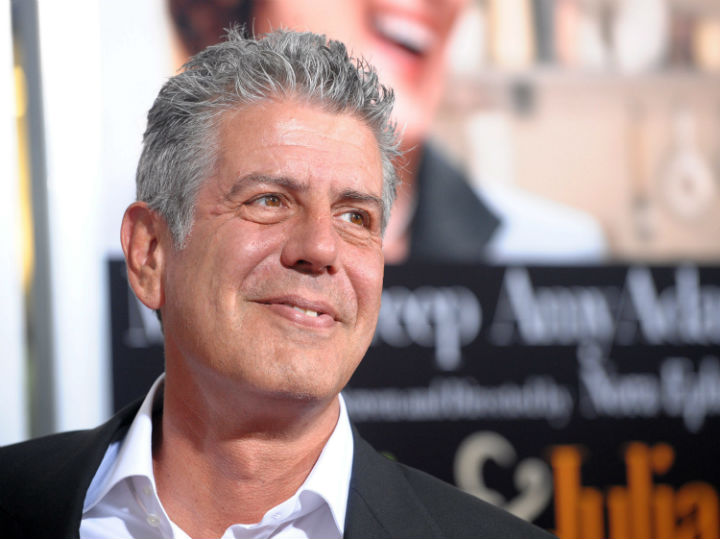VANCOUVER – Proponents of Canada’s seal hunt have found a celebrity ally — something that doesn’t often happen — in chef, author and television show host Anthony Bourdain.

Bourdain took jabs at fellow chefs who signed their names to a Humane Society of the United States campaign calling for a boycott of “Canadian seafood or seafood from sealing provinces until Canada’s commercial seal slaughter ends.”
“… These chefs are giving Canada’s fishing industry a clear message—it is not acceptable for fishermen in Canada to club and shoot hundreds of thousands of seal pups in a reckless mass slaughter that takes place every year off Canada’s east coast,” read the Humane Society statement.
Bourdain, 57, is no stranger to speaking his mind and he did just that on his personal Twitter account on Monday, taking particular issue with how demands for a complete ban on sealing would affect indigenous communities in Canada’s north.
Bourdain visited northern Quebec in 2006, with his Travel Network show Anthony Bourdain: No Reservations, to take part in a traditional Inuit seal hunt and feast.
Although he said he was at one point “rooting for the seal” and even admitted watching the slaughter of the lone seal for family sustenance was not the most pleasant thing to watch, Bourdain sampled each part of the freshly-killed raw seal — including “the best part,” the eyeball.
He pointed out nothing goes to waste when a seal is brought home after a hunt.
Bourdain drew from that experience to make his case to his colleagues on Monday.
Terry Auldla, president of the Ottawa-based Inuit organization Inuit Tapiriiit Kanatami (ITK), welcomed Bourdain’s support.
Even if it doesn’t change everyone’s thinking on seal hunting, he said “whatever little bit helps.”
As far as the Inuit are concerned, he said seal hunting is a vital part of life in the North.
He estimated indigenous hunters kill about 5,000 seals a year — a fraction of what’s hunted by the commercial seal hunters.
The Humane Society makes no reference to the indigenous seal hunts in its statement online last week.
Speaking to Global News on Tuesday, the Humane Society’s Director of Wildlife Protection said the campaign in no way targets the “native subsistence hunt.”
“This is a commercial hunt undertaken by commercial fishermen for the fashion industry,” Kathryn Kullberg said in a phone interview.
Kullberg explained the Chefs for Seals campaign is calling for a boycott of Canada’s seafood industry because it is “clearly linked” to the seal hunt.
- Life in the forest: How Stanley Park’s longest resident survived a changing landscape
- ‘Love at first sight’: Snow leopard at Toronto Zoo pregnant for 1st time
- Buzz kill? Gen Z less interested in coffee than older Canadians, survey shows
- Carbon rebate labelling in bank deposits fuelling confusion, minister says
“These fishermen do not make a living from killing seals. They kill during a very small portion of their off-season,” she said.
Kullberg said the animals are killed while they are still pups.
She acknowledged the seals cannot legally be killed until after they are 14 days old and have molted their white coats, but she said at two weeks old the animals are still pups.
Kullberg said many of the animals are skinned alive, although the Dept. of Fisheries and Oceans (DFO) said hunters are required to verify the animal is dead and “bleed the animal for a minimum of one minute” before they can skin it.
She said 800,000 people have signed onto its anti-seal hunt campaign, in addition to 6,500 grocery stores, restaurants and other businesses.

According to Canada’s DFO, Canada is the world’s largest exporter of seal products, which include pelts, oil and meat.
But in the last couple of years, the number of seals harvests has fallen significantly below the quotas, with 2011 called one of the worst years on record.
DFO determines its annual hunt quotas based on the estimated size of the seal population, which the department says is at its highest level in 30 years and “in no way an ‘endangered species.'”
In an email to Global News, DFO spokesperson David Walters said 90,703 seals were harvested in 2013, based on preliminary estimates. He said that was far below the total allowable catch of 400,000.
The majority of the harvest takes place between late March and the middle of May, in waters of Newfoundland and Labrador and the Gulf of St. Lawrence. Residents of Canada’s Arctic and areas north of the 53rd parallel can hunt seals at any time throughout the year for subsistence.
The department monitors the effect an abundant seal population has on the Atlantic cod.
“Scientific research suggests that grey seal predation could account for much of the high natural mortality of cod in the southern Gulf of St Lawrence. At current rates of natural mortality, stock growth is not likely unless productivity increases well above levels observed in the past decade,” a post on DFO’s website reads.
The cod debate is another argument Bourdain uses to make his case.
*With files from The Canadian Press




Comments